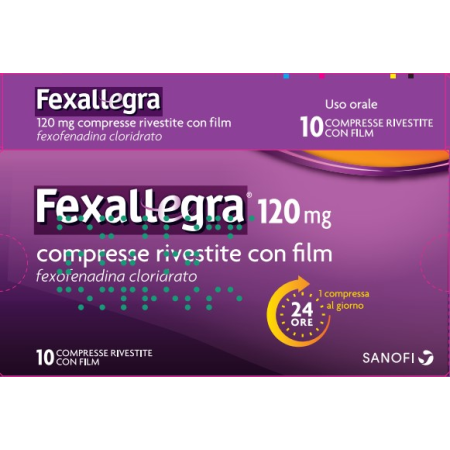FEXALLEGRA*10CPR RIV 120MG
Therapeutic indications
Fexallegra is indicated in adults and children from 12 years of age for the symptomatic treatment of allergic rhinitis.
Dosage and method of use
Dosage AdultsThe recommended dose of fexofenadine hydrochloride for adults is 120 mg once daily, before meals. Fexofenadine is a pharmacologically active metabolite of terfenadine.Pediatric population Children 12 years of age and olderThe recommended dose of fexofenadine hydrochloride for children aged 12 years and older is 120 mg once a day, before meals.Children under 12 years of ageThe efficacy and safety of fexofenadine hydrochloride 120 mg have not been studied in children under 12 years of age. In children 6 to 11 years of age: fexofenadine hydrochloride 30 mg tablets is the appropriate formulation for administration and dosing in this population.Particular populationsStudies carried out in risk groups of patients (elderly, patients with renal or hepatic insufficiency) indicate that it is not necessary to adapt the dose of fexofenadine hydrochloride in these patients.
Contraindications
The medicine is contraindicated in patients with hypersensitivity to the active substance or to any of the excipients listed in paragraph 6.1.
Side effects
The following frequency class has been used when applicable: very common (≥ 1/10); common (≥ 1/100 eNervous system disorders.Common: headache, drowsiness, dizziness. Gastrointestinal disorders. Common: nausea. General disorders and administration site conditions. Uncommon: fatigue. In adults, the following side effects have been reported during post-marketing surveillance. The frequency with which they occur is not known (an estimate cannot be made based on the available data): Immune system disorders: Hypersensitivity reactions with manifestations such as angioedema, chest tightness, dyspnoea, hot flushes and systemic anaphylaxis. Psychiatric disorders: Insomnia, nervousness, sleep disturbances or nightmares/excessive dreaming (paronyria). Cardiac disorders: Tachycardia, palpitations. Gastrointestinal disorders: Diarrhea. Skin and subcutaneous tissue disorders: Rash, urticaria and itching.Reporting of suspected adverse reactionsReporting suspected adverse reactions that occur after authorization of the medicinal product is important, as it allows continuous monitoring of the benefit/risk balance of the medicinal product. Healthcare professionals are asked to report any suspected adverse reactions via the national reporting system at https://www.aifa.gov.it/content/segnalazioni-reazioni-avverse.
Special warnings
Data in elderly subjects and patients with impaired renal or hepatic function are limited. Fexofenadine hydrochloride should be administered with caution to these groups of subjects (see section 4.2). Patients with previous or current cardiovascular disease should be informed that antihistamines, as a class of medicinal products, have been associated with adverse reactions such as tachycardia and palpitations (see section 4.8).Fexallegra contains sodiumThis medicinal product contains less than 1 mmol (23 mg) sodium per tablet, i.e. essentially 'sodium-free'.
Pregnancy and breastfeeding
PregnancyThere are no adequate data on the use of fexofenadine hydrochloride in pregnant women. Limited animal studies do not indicate direct or indirect harmful effects with respect to pregnancy, embryonic/foetal development, parturition or postnatal development (see section 5.3). Fexofenadine hydrochloride should not be used during pregnancy unless absolutely necessary.Feeding timeThere are no data on the concentration in breast milk after administration of fexofenadine hydrochloride. However, when terfenadine was administered to breastfeeding mothers, fexofenadine was found to pass into breast milk. Therefore the use of fexofenadine hydrochloride is not recommended during breastfeeding.FertilityNo data are available on the effect of fexofenadine hydrochloride on human fertility. In mice, treatment with fexofenadine hydrochloride showed no effect on fertility (see section 5.3).
Expiration and conservation
This medicinal product does not require any special precautions for storage.
Interactions with other drugs
Fexofenadine does not undergo hepatic biotransformation and therefore will not interact with other medicinal products at the level of hepatic mechanisms. Coadministration of fexofenadine hydrochloride and erythromycin or ketoconazole has been found to increase plasma levels of fexofenadine 2-3-fold. These alterations were not accompanied by any effect on the QT interval and were not associated with any increase in adverse reactions compared to that observed with the same medicinal products administered individually. Animal studies have shown that the increase in plasma levels of fexofenadine observed after concomitant treatment with erythromycin or ketoconazole appears to be caused by an increase in gastrointestinal absorption and a decrease in both biliary excretion and gastrointestinal secretion, respectively. No interaction was observed between fexofenadine and omeprazole. However, administration of an antacid containing aluminum and magnesium hydroxide 15 minutes before administration of fexofenadine hydrochloride resulted in a reduction in bioavailability, most likely due to binding in the gastrointestinal tract. An interval of 2 hours is advisable between the administration of fexofenadine hydrochloride and antacids containing aluminum and magnesium hydroxide.
Overdose
Dizziness, drowsiness, fatigue and dry mouth have been reported following overdose of fexofenadine hydrochloride. Single doses of up to 800 mg and doses of up to 690 mg twice daily for one month or 240 mg once daily for one year have been administered to healthy volunteers without resulting in clinically significant adverse reactions when compared to placebo. The maximum tolerated dose of fexofenadine hydrochloride has not been established. Standard measures to remove unabsorbed drug should be considered. Symptomatic and supportive treatment is recommended. Hemodialysis does not effectively remove fexofenadine hydrochloride from the blood.
Active principles
One tablet contains:Active principle:120 mg of fexofenadine hydrochloride, equal to 112 mg of fexofenadine. For the full list of excipients, see section 6.1
Excipients
Tablet coremicrocrystalline cellulose; pregelatinized corn starch; croscarmellose sodium; magnesium stearateFilm coatinghypromellose; povidone K30; titanium dioxide (E171); anhydrous colloidal silica; macrogol 400; red iron oxide (E172), yellow iron oxide (E172).

 Convenient and safe payments
Convenient and safe payments
 Shipping in 24h all over the world
Shipping in 24h all over the world
 Fast returns
Fast returns
 Pharmaceutical experience
Pharmaceutical experience












